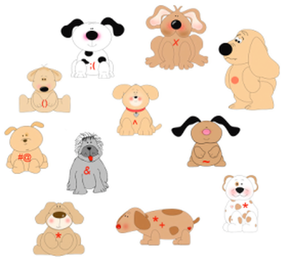But some rules are grounded solidly in paradigms that all breeders need to both understand and honor, or the consequences will be significant and severe.
Flyckt-Pedersen asks:
"So where did all this nonsense about “inbreeding coefficient” and...restrictions about how many times a dog could be used at stud in his lifetime come from?"
These are not new "rules". In fact, commercial animal breeders of 100 years ago abided by simple rules regarding inbreeding and popular sires, because experience told them that ignoring these things had negative consequences that mattered to them.
For inbreeding coefficients, they knew that inbreeding reduced the "vigor" of their stock and increased the incidence of health issues. Before understanding the basic principles of genetics, they worked out that inbreeding affected their bottom line, and they wanted a way to assess the inbreeding of a particular animal and judge how much inbreeding was "too much". This problem was of interest to the USDA, which was trying to improve the efficiency of animal breeding, so one of their statisticians working on animal breeding derived a simple way breeders could estimate the level of inbreeding of any animal, even when the pedigree interrelationships of dogs were complicated. This fellow was Sewell Wright, and he devised Wright's coefficient of inbreeding (COI), which used basic principles of genetics, probability, and statistics to quantify the level of inbreeding of any animal from its pedigree. He understood that inbreeding had both positive and negative consequences, and the trick for breeders would need to be achieving the perfect balance between the good and bad of inbreeding. With Wright's quantitative estimate of inbreeding, breeders were finally able to do this.
While animal breeding in general entered the age of modern genetics, dog breeding remained essentially unchanged. Even with the availability now of DNA testing, the dog fancy continues to use the breeding methods of yesterday. The commercial animal breeders of Wright's time would be able to explain to the dog fancier what to expect from breeding programs that ignored inbreeding - smaller litters, higher puppy mortality, shorter lifespan, less "vigor"; pretty much less of everything that defined the quality and value of the animal.
So, Flyckt-Pedersen asks where did the "nonsense" of inbreeding coefficients come from? It comes from the basic principles of genetics that are the foundation of Wright's coefficient of inbreeding. Inbreeding coefficients most certainly did not suddenly appear; I would argue that it has been hiding in pain sight. It's been around for a century and continues to provide the foundation of successful breeding programs of all domestic animals (except dogs). In the last two decades, a far-sighted group of dog breeders with a scientific bent and interest in how things work began to understand the importance of population genetics in sustainable breeding of population sof animals. To this end, they homed right in on the consequences of inbreeding and how the inbreeding coefficient could be an essential tool for managing the health and quality of purebred dogs. While the circle of influence of these pioneers continues to spread, there are still many in the dog fancy that reject the notion that inbreeding can be detrimental and thus critically important for breeders to understand. These young breeders are hungry for information that will help them produce dogs of health and quality, and inevitably the older generation will pass on, and science instead of opinion and ideology will be the foundation of successful breeding of purebred dogs in the future.
As for restrictions on the number of times a sire can be used. Once again, these come from understanding the genetics of animal breeding. The reason for restrictions is very easy to understand the basic principles, and I refer you to this very basic blog post, The Pox of Popular Sires, that I wrote nearly a decade ago to guide you through understanding the consequences of popular sires.
You can dislike (and choose to not understand) laws that restrict breeding in particular ways, but it's science that will provide us with the understanding necessary to make the best possible decisions when we contemplate our next litter.
Wright, S. 1922. Coefficients of inbreeding and relationship. American Naturalist 56: 330-338. (PDF)
ICB's online courses
***************************************
Visit our Facebook Groups
ICB Institute of Canine Biology
...the latest canine news and research
ICB Breeding for the Future
...the science of animal breeding


